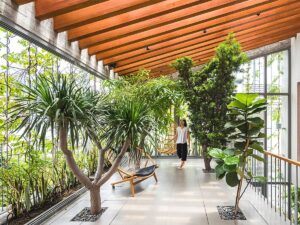Creating spaces that truly reflect their users
Biophilia, ‘love of nature’ in Latin, is a term coined by Harvard socio-biologist Edward O. Wilson to describe the human need to associate ourselves with nature. Biophilic Design emerged as architecture’s response to this human need, designing buildings that connect residents with nature.
Americans spend on average 93% of their time indoors, of which 87% is time at home. (Incl. footnote: National Human Activity Pattern Survey – NHADS.) So designing residences that are aesthetically pleasing, and enhance residents’ health and wellbeing is more important than ever.
Biophilic designed spaces have shown to improve the well being of its occupants, as the connection with nature promotes health and comfort, reduces stress, and increases stamina, focus and productivity. (Incl. footnote: FPI Innovation, Wood and Human Health; Thinkwood: Designing Beneficial Living Spaces.)

Key patterns of Biophilic Design include a visual and material connection with natural elements, the use of dynamic and diffuse natural light, biomorphic forms and patterns, thermal and airflow variability, presence and sound of water, and unimpeded views for spaces to feel open and free, enclosing only functions needing privacy and separation.
Some Biophilic Design patterns are more difficult to describe without experiencing them, like the use of non rhythmic sensory stimulation, or making spaces more engaging by contrasting complexity with order, and also introducing sensory devices for residents to travel deeper into the environment, creating a sense of mystery and palpable anticipation. Of this type of pattern I much enjoy the use of partially revealed views and sinuos curves, creating dramatic shadows compelling you to go see what’s around the corner…
And yet other Biophilic patterns are very subdued, like creating spaces to refuge residents from the main flow of activity, spaces that feel safe and provide a sense of relief and withdrawal, be it for rest or healing, or for work, and either alone or in small groups. My favorite in this category are private reading nooks, enclosed in wooden frames and overlooking lush outdoor greenery, for you to dream and do make dreams your master.
The standards for a Biophilic Designed wellness focused building like Toussaint Ateliers, overlap with the standards the building needs to comply with to obtain its sustainable building certification, for example the use of exposed natural wood both as part of the building’s structure, and as interior finish material. Natural wood improves the way people feel inside a building, as humans associate the grain, texture, visual warmth, and color of wood with nature. In my next blog more about using natural wood to build aesthetically beautiful spaces that enhance human well being.

